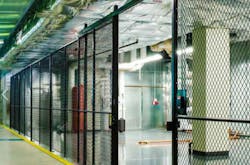The Benefits of Washington State’s Hydropower and Energy Efficiency
Tim Mirick, Chief Revenue Officer at Sabey Data Centers highlights how Washington’s hydropower and energy efficiency efforts create the perfect environment for data center sustainability.
Tim Mirick, Senior Vice President of Sales and Marketing, Sabey Data Centers
These times of uncertainty and unforeseen circumstances are forcing a re-write of many business playbooks. Still, it makes sense to keep in mind the value of constants – the qualities and quantities of resources that are relatively unaffected by external influences.
Such is the case with hydropower, which provides some of the lowest and most predictable electricity rates. As a clean, renewable and reliable energy resource, the abundant hydropower generated in Washington State significantly lowers operating expenses for data centers, keeping costs down.
Sustainable and Strategic Energy
As significant energy consumers, those in the data center sector have embraced a greater responsibility than most to be good stewards of our resources while reducing our carbon output. Hydropower as a green energy source is ideal for running sustainable data centers which significantly reduce environmental impact. Hydroelectricity also offers the key advantage of being able to align electricity generation more closely with their supported loads.
Massive Green Energy Production
Generating roughly 10% of the energy used throughout the United States, hydroelectric power plants provide natural and renewable energy at low production costs. Of these facilities, the Grand Coulee Dam on Washington’s Columbia River is the largest producer in the United States by far, with a total generating capacity of 6.8 million kilowatts of energy. That’s nearly 2 million more than Niagara Falls, including both the U.S. and Canadian sides of the border. To get the same peak output, one would need 3,400 2-megawatt wind turbines or 17,000 acres of photovoltaic panels; and the Grand Coulee Dam can continue generating power even when there is no wind or sun.
Responsible Path with Dramatic Financial Benefits
Not only are the region’s energy costs the lowest in the nation at $0.03/kWh (a nearly five-fold decrease from California’s $0.14/kWh rate) but central Washington is also unique in its ability to provide companies with climate-specific cooling options. The region’s naturally cool climate provides data centers with major cost-savings for cooling, and therefore, a significant decrease in operational expenses. Industry-wide, energy efficiency is a holy grail for data center owners and operators seeking low operational expense and minimal environmental impact.
The proximity of Sabey’s Washington State data centers to multiple renewable energy resources in the comparatively cool Pacific Northwest climate places it in a prime position to take advantage of free cooling techniques.
Nonetheless, the exponentially increasing rate of data generation has prompted significant concern about how power is being utilized to store and process this information. According to the Natural Resources Defense Council, data centers in the U.S. alone are projected to consume 139 billion kilowatt-hours this year. Driven by our adoption of technology and the associated application growth, this consumption would place a dangerous strain on environments and budgets without continued strides made in efficiency.
Cool Climate and Technology Converge for Sustainability Savings
Sabey Data Centers’ commitment to minimizing its carbon footprint and providing customers with affordable energy costs is reflected in the design of Intergate.Quincy – its Quincy, Wash. facility. Achieving Energy Star certification with a score of 100 for three consecutive years due to its energy efficient design and operation, this facility utilizes hydroelectricity to power its IT equipment and auxiliary needs.
Sabey’s Intergate.Seattle data center stands as an early model of sustainability and efficiency in an urban area. It is the largest privately-owned multi-tenant data center complex on the West Coast and Sabey’s flagship data center property. The facility comprises two campuses, nine buildings and more than 1.3 million square-feet of data center space.
The proximity of Sabey’s Washington State data centers to multiple renewable energy resources in the comparatively cool Pacific Northwest climate places it in a prime position to take advantage of free cooling techniques.
Sabey pioneered cooling research in the early 2000s as the industry discovered that many facilities were being over-cooled utilizing inefficient methods. We developed new cooling techniques that use thermodynamics to its advantage, and today we adhere to the design philosophy of keeping it simple, efficient, and cost-effective.
Connectivity Matters
Washington State also boasts a robust and diverse fiber optic network that delivers a wide range of carrier-neutral connectivity options including dark fiber, Dedicated Internet Access (DIA), point-to-point interconnectivity, peering exchanges, next-gen networks and on-ramps to the cloud from virtually any location. In addition, Trans-Pacific cables have landings on both the Washington and Oregon beaches and can be connected to Central Washington with as little latency as four milliseconds.
Cloud Capital of the West Coast
For years, engineering teams wanted data centers to remain physically close to their operations headquarters. But that has become less important considering the tremendous and beneficial advances in sustainable operating practices and the attendant vast improvements in the digital infrastructure. Most recently, Washington State has made a name for itself in the data center sector for hosting the digital assets of California-based enterprises.
Thanks to these benefits, Washington is currently experiencing rapid growth across its data center market, with Seattle earning the moniker of “Cloud City” for its abundance of cloud computing businesses. Recognizing the benefits of hosting data in Washington, Sabey Data Centers has brought to market a combined 2.2 million square feet of data center space throughout Washington State, and is providing tenants with access to reliable, price-stabilized affordable power via sustainable generation, superior connectivity and turnkey infrastructure deployment.
Tim Mirick is the Chief Revenue Officer at Sabey Data Centers.





